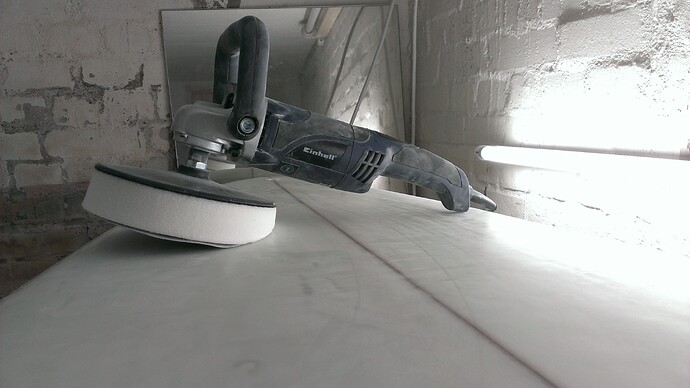Hi,
I’m a first-time builder, long time lurker from Germany and now I could need some advice regarding hotcoat sanding (epoxy). I searched the archives but found nothing match my questions exactly… (many threads are also no more accesible, but I guess you know that).
Backround info: My first board is a 6.10’ x 23’’ x 3’’ round tail, inspired by the Clark Foam cataloge and Fatum Surfboards from Portugal. The core is 2 Ibf³ eps with a pinewood stringer (not sealed). I glassed the board with epoxy resin and 1x bottom layer, 1x top layer and a deck patch (all 7oz. e-glass). Hotcoat resin without any surface agents.
Now to my questions:
1) I powersanded the hotcoat, starting with 120 grit on the foam pad at 1.000-1.200 rpm to get rid of the shine (I want a matte finish, no glosscoat). It went quite good, besides several little spots remained shiny (looking like a leopard pattern, see photos) though I was sanding an hour or more per side. Clearly these are uneven spots which are most likely existing since shaping the board. How would you go on? Since I started with 120 grit I’m considering going down to 80 to get it real even (remove the shiny leopard pattern), then going on with 120, 180, 240, 320 and stop.
This would probably lead to some sand-throughs (already got one sanding the leashplug down with 80 grit and no pad, just the little flexible rubber pad,). But after touching the sand-throughs up with little resin, it should be easier so get it smooth, or is this not a good idea? With sand-through I mean visible cloth texture, no foam (see photo).
On my next board, I’ll seal the core and hope this and my now gained experience (work clean on every step) help to eliminate most of the uneveness.
2) My powersander (photo) has a rpm-range from 1.000 - 3.500. Am I going too slow with 1.000-1.200 rpm? Also the sandpaper clogs a bit. Little spots on the sandpaper from hardened resin dust. Does this come from too much pressure?
3) I did a touch up with a small batch of resin. The resin hardened with trapped bubbles (see photo). Do you guys have a good tip of how to mix resin with lesser air bubbles?
Big thanks in advance for any advice you can give a bloody rookie! ![]()
Greetings from Germany,
Gordon_Shumway






